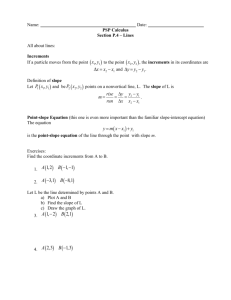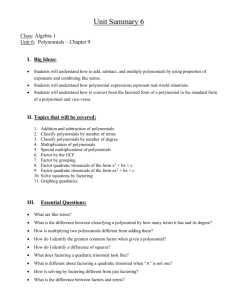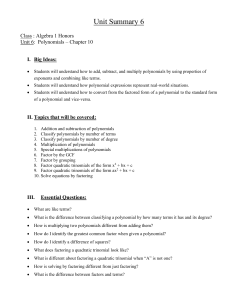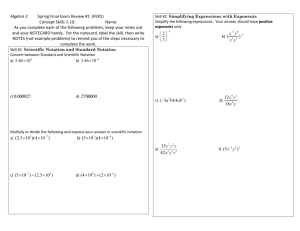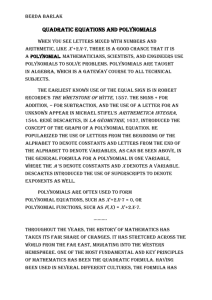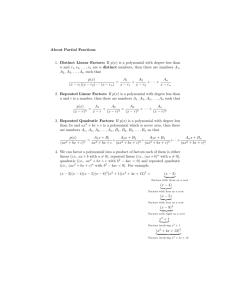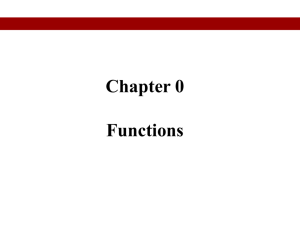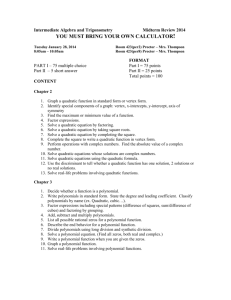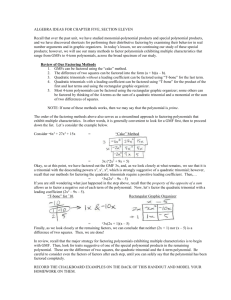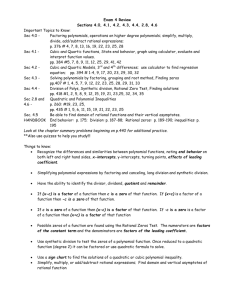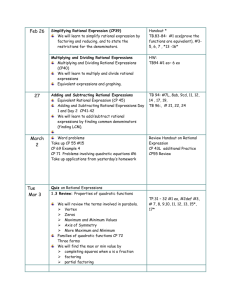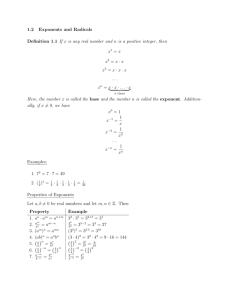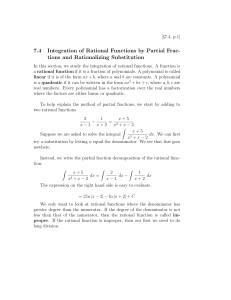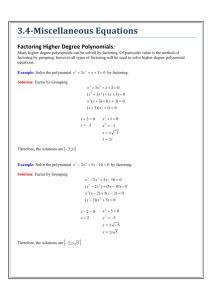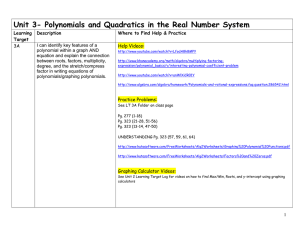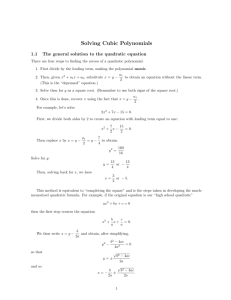Exam 1 Study Guide
advertisement
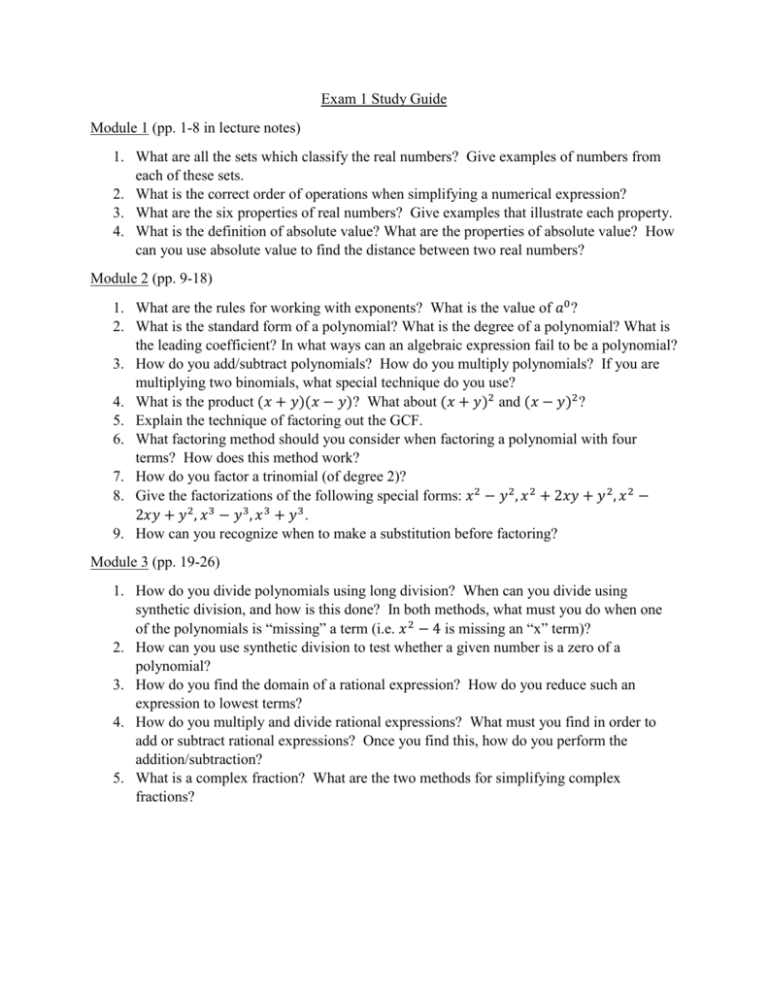
Exam 1 Study Guide Module 1 (pp. 1-8 in lecture notes) 1. What are all the sets which classify the real numbers? Give examples of numbers from each of these sets. 2. What is the correct order of operations when simplifying a numerical expression? 3. What are the six properties of real numbers? Give examples that illustrate each property. 4. What is the definition of absolute value? What are the properties of absolute value? How can you use absolute value to find the distance between two real numbers? Module 2 (pp. 9-18) 1. What are the rules for working with exponents? What is the value of 𝑎0 ? 2. What is the standard form of a polynomial? What is the degree of a polynomial? What is the leading coefficient? In what ways can an algebraic expression fail to be a polynomial? 3. How do you add/subtract polynomials? How do you multiply polynomials? If you are multiplying two binomials, what special technique do you use? 4. What is the product (𝑥 + 𝑦)(𝑥 − 𝑦)? What about (𝑥 + 𝑦)2 and (𝑥 − 𝑦)2 ? 5. Explain the technique of factoring out the GCF. 6. What factoring method should you consider when factoring a polynomial with four terms? How does this method work? 7. How do you factor a trinomial (of degree 2)? 8. Give the factorizations of the following special forms: 𝑥 2 − 𝑦 2 , 𝑥 2 + 2𝑥𝑦 + 𝑦 2 , 𝑥 2 − 2𝑥𝑦 + 𝑦 2 , 𝑥 3 − 𝑦 3 , 𝑥 3 + 𝑦 3 . 9. How can you recognize when to make a substitution before factoring? Module 3 (pp. 19-26) 1. How do you divide polynomials using long division? When can you divide using synthetic division, and how is this done? In both methods, what must you do when one of the polynomials is “missing” a term (i.e. 𝑥 2 − 4 is missing an “x” term)? 2. How can you use synthetic division to test whether a given number is a zero of a polynomial? 3. How do you find the domain of a rational expression? How do you reduce such an expression to lowest terms? 4. How do you multiply and divide rational expressions? What must you find in order to add or subtract rational expressions? Once you find this, how do you perform the addition/subtraction? 5. What is a complex fraction? What are the two methods for simplifying complex fractions? Module 4 (pp. 27-36) 1. What is the meaning of a negative exponent? What is the quotient rule for simplifying exponents? 2. If a number has a rational exponent, what does the numerator indicate? What does the denominator indicate? When is the expression 𝑎𝑚⁄𝑛 undefined? 3. When factoring an expression with negative exponents, which power should you factor out? 4. How do you convert from radical notation to exponential notation? What are the four rules for combining radicals? Under what conditions is a radical expression completely simplified? 5. When can you add/subtract radicals, and how is this done? 6. What are the two standard techniques for rationalizing the denominator (one if denominator is a monomial, another if denominator is a binomial)? Module 5 (pp. 37-44) 1. What is the form of a linear equation? How do you solve a linear equation? 2. How do you classify an equation as an identity, conditional equation, or a contradiction? What is the solution set of each type? 3. What is the formula for simple interest? What do all the variables represent? 4. What steps should you take when solving a word problem? Understand how this applies to problems dealing with geometry, motion, mixture, and investment. Module 6 (pp. 45-52) 1. What is the form of a quadratic equation? What are the four main methods for solving a quadratic equation? Which two are guaranteed to work for every quadratic equation? 2. What are the steps to solving a quadratic equation using completing the square? 3. What is the quadratic formula? What is the Pythagorean Theorem? 4. Understand how to solve word problems leading to quadratics, involving geometry and projectile motion. Module 7 (pp. 53-62) 1. What equation defines the imaginary unit i ? What is the standard form of a complex number? What are the real and imaginary parts? When is a number pure imaginary? 2. How can you simplify radicals of negative numbers? How do you add complex numbers? How do you multiply complex numbers? 3. What is the complex conjugate of a complex number 𝑎 + 𝑏𝑖? What is the standard technique for simplifying quotients of complex numbers? 4. How can you evaluate powers of i? 5. What is the discriminant of a quadratic equation? What do you know about the solutions to such an equation if the discriminant is positive? What if the discriminant is zero? What if the discriminant is negative?
